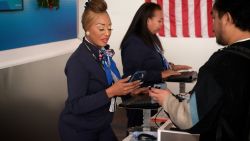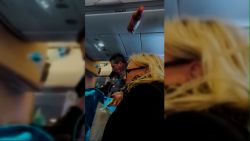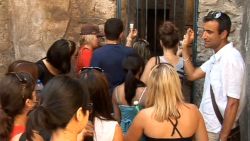When most students take a gap year between high school and university, it’s usually a backpacking adventure or to build up work experience and savings before college.
But Zara Rutherford isn’t most people.
On August 18, the 19-year-old is setting off on the trip of a lifetime: a 32,000-mile journey around the world. More than that, she’ll be flying herself.
“It’s a dream I’ve had for a really long time, but it always seemed unrealistic,” says Rutherford, who holds dual British-Belgian nationality. “When I decided to take a year out before I go to university, I realized, I’ve got all this time – I might as well do something crazy with it.”
Flying in a bespoke Shark ultralight, which she says is the world’s fastest microlight aircraft, Rutherford hopes to set the record for the youngest woman to solo circumnavigate the globe – and inspire more girls and women to pursue careers in science and aviation.
Two months, 52 countries
Rutherford isn’t new to flying. Both her parents are pilots and Rutherford has been learning to fly since she was 14 – although she only started formal flying lessons and got her first license in 2020.
With over 80 flight hours officially logged, and hundreds more uncounted, Rutherford describes her flight experience as “quality over quantity.” She’s gained extra experience helping her parents with their plane “ferrying” service which involves moving aircraft between locations: one trip involved helping her father move a plane from the US to Jordan.
“I’ve already seen a bit of the route, so I know what to expect,” she adds.
Starting in Belgium, Rutherford’s route takes her west through 52 countries, five continents, and crosses the equator twice – first in Tumaco, Colombia, and again in Jambi, Indonesia – which is part of the Guinness World Records’ requirements for an around-the-world flight.
The two-month trip is self-funded, and the teenager has sold her car to help pay for it, as well as seeking out sponsors.
Another cost of the trip is the environmental impact. While Rutherford says the total fuel for her trip is the equivalent to the amount used in 10 minutes by a Boeing 747, she’s spending €600 ($710) on tree-planting projects to offset her carbon footprint.
Rutherford will fly using “visual flight rules” – meaning she has to be able to see clearly where she is going to avoid obstacles and stay on route, so she won’t be flying at night or in poor weather conditions. Stopping for just one or two nights in each location, she plans to meet with schools and youth groups in different countries – which she hopes will bring more visibility to aviation for young girls, to show them “they can really reach for anything they want.”
Women in aviation
Creating awareness of women in aviation is a key part of Rutherford’s mission. According to the International Society of Women Airline Pilots (ISA), just 5.1% of airline pilots around the globe are women — far below many other science, tech, engineering, and mathematics (STEM) professions.
“[5%] is such a small number, considering it’s a career where you basically get paid to travel around the world — obviously it’s work, but it’s an amazing career with amazing opportunities,” says Rutherford.
Currently, the youngest female pilot to solo circumnavigate the globe in a single-engine plane is Shaesta Waiz, who was 30 years old at the time. Rutherford points to the gap between the male and female records — Travis Ludlow was just 18 years old when he became the youngest person to circumnavigate the globe solo in July 2021 — as one of the many indicators of the disparity between men and women in aviation.
Visibility is key to showing young women the possibilities, says Rutherford. To help get more women and girls involved in science fields early, Rutherford is supporting two charities on her trip: Girls Who Code, which supports young women entering computer science, and Dreams Soar, a non-profit founded by current record-holder Waiz, that supports women and girls entering STEM fields.
With sponsors including Virgin and Holly Branson (daughter of Richard Branson), Rutherford hopes to raise both funds and awareness for these charities, as well as lessen the “dream gap” and be a role model for young girls, as her mother and father were for her growing up. “I think by seeing other women in aviation, in computer science and STEM it normalizes it a lot more,” she says.
A more accessible aircraft
One of the things making the trip possible is Rutherford’s microlight aircraft. Microlights are small one or two-seat planes used for leisure or personal transport. If she completes her trip, Rutherford will also claim the record for the youngest person to circumnavigate the world solo in a microlight aircraft.
14 aircraft that changed the way we fly
On loan from Shark Aero, one of her sponsors for the trip, the Shark Ultralight Rutherford will fly in has been customized for her needs, including a second radio, satellite communications which will allow her to call anyone at any time during the flight, and an additional fuel tank where the second passenger seat would usually be, which will add over 1,000 kilometers to her flight range.
While the plane is “perfectly capable” of making the trip without these modifications, Zara’s father Sam Rutherford says these changes have given both him and Zara an extra sense of security.
“It is the fastest microlight in the world, with a whole raft of safety systems and solutions as well,” he says.
Microlights are a more accessible option for potential aviators, says Zara Rutherford. She hopes that her trip will also highlight the possibilities of microlight aircraft for beginner aviators, and inspire more young women and girls to try flying.
“It’s an easy thing to say, but just go for it,” she says. “If you don’t try and see how high you can fly, then you’ll never know.”


























